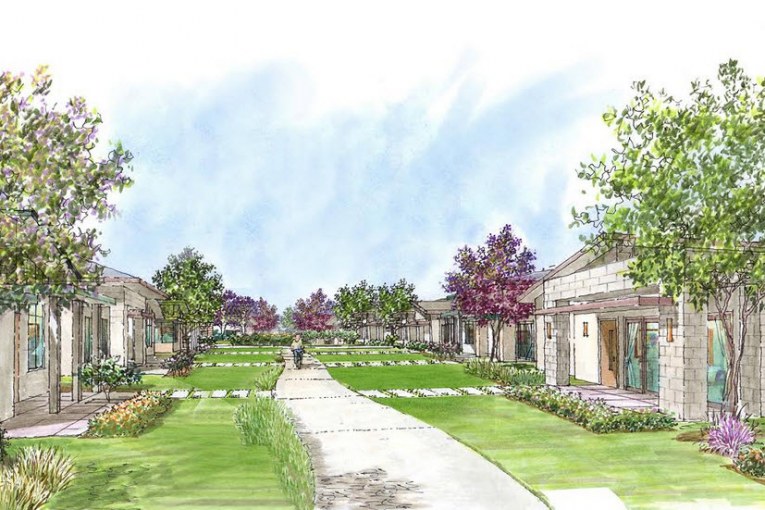

On Monday, David Taormino responded to staff at the Open Space and Habit Commission hearing. The following is his letter to the commission.
Dear Commissioners,
Below is my response to the Staff Report Recommendations.
Response to Staff Report Recommendations, Background and Analysis:
I am not appealing the original Tentative Map Conditions. nor your original commission recommendations, nor the Development Agreement. I was ready to design according to these conditions when Public Works staff said, essentially: We want to eliminate the “natural creek bottoms” and substitute stamped concrete and “multiple ledges”.
I am willing to support certain staff-initiated changes set forth in the Staff Report, but these changes result in different infrastructure requirements that were not contemplated when the DA and map conditions were agreed on with the City Council and Planning Commission.
Discussion and my alternatives to staff requested changes:
- Concrete lined bottom of all four tunnels: two tunnels along Covell Blvd and two at the north Bretton Woods channel connecting to the new John Jones Detention Pond. I am agreeable. It contributes to good maintenance practices and minimization of clogging.
- I am in agreement that all four tunnels are to be built without custom stamped concrete as initially required by staff as a replacement for natural creek bottom. This also eliminates the need for oversizing the tunnels.
- Ledges in all four tunnels: I am not entirely agreeable as explained
My Recommended Alternative and Explanation:
The original ostensible and practical purpose of ledge(s) was to provide a “dry” walkway under Spirit Street somewhat akin to the current ledges on the foundations of the two corrugated steel tunnels under Risling. (see John McNerney’s example photo attached: Culvert Wildlife Ledge example 2)
I agreed to the concept of ledge(s) because the ledge(s) were an integral part of the foundation for tunnels with natural creek bottoms as specified in the Tentative Map Conditions. Those foundations with ledge(s) are necessary to build such tunnels. When changing to four-sided concrete tunnels without a natural creek bottom. no foundation is needed. The four sides of the concrete tunnels are smooth (see photo of typical tunnel attached), thus any ledge needs to be hand made and hand installed in a space that has only four feet of height to work in. It is time and labor intensive.
My alternative: Install a 2 X 8 redwood board ledge along the length of the tunnel and attached to the wall of the tunnel closest to the North edge of the Covell Channel, located furthest from Covell Blvd. Anchor the redwood ledge to the side/top of the Covell Channel for ease of animal access. This redwood ledge provides animals a safe below-grade route (below Spirit Drive). It would be located away from Covell Blvd and closer to the landscaping on top of the channel. One 2 X 8 board inside the length of the tunnel will not likely impede water flow in heavy rains and would require little city maintenance. This location is the safest connection point to where animals are likely to walk. (See attached drawing of the tunnels originally proposed by Staff for a visual.) Having one conveniently located ledge with above ground access is ample considering the overall likely use is by smaller critters like possums, skunks, racoons, etc. that will use the side or bottom of the Covell Channel and landscaping for cover. In John McNerney’s report he states:
“I recommend that the City uphold the agreed upon wildlife conservation measures for the project including the installation of culvert wildlife undercrossings. It is my opinion that while the Covell and John Jones Road drainage channels are not significant migratory corridors for wildlife. they do provide cover and movement habitat for small to medium sized urban wildlife. Installing new roads across these channels will indeed create a barrier to wildlife movement and increase the risk of vehicle strike mortality. Installing the wildlife ledges, as proposed, is a relatively cheap and effective method to provide safe passage for wildlife.” (Emphasis mine)
Conclusion on Covell Channel Tunnel: One ledge closest to the landscaping meets the intent of providing a safe alterative below ground path under Spirit Street for animals to avoid cars and is consistent with expected use. North Bretton Woods channel tunnels (2).
My Recommendation: No ledges necessary.
Explanation: Unlike the Covell Channel, there is no street crossing that impedes the animals from moving safely from the Bretton Woods Channel to the John Jones Detention Pond and vice versa. The two north Bretton Woods Channel tunnels go from one “open space” area to another. Any animal prevented by drainage water from using the underground tunnels below the levee can simply walk over the top of the levee from one side to the other. A ledge is unnecessary since there is no street to cross nor other impediment for a safe crossing. The overland route is no different than going up one side and down the other side of the dirt channel.
Respectfully Submitted, Dave Taormino
Bretton Woods


What the developer proposes in his letter seems perfectly reasonable. Hopefully this puts an end to this controversary.